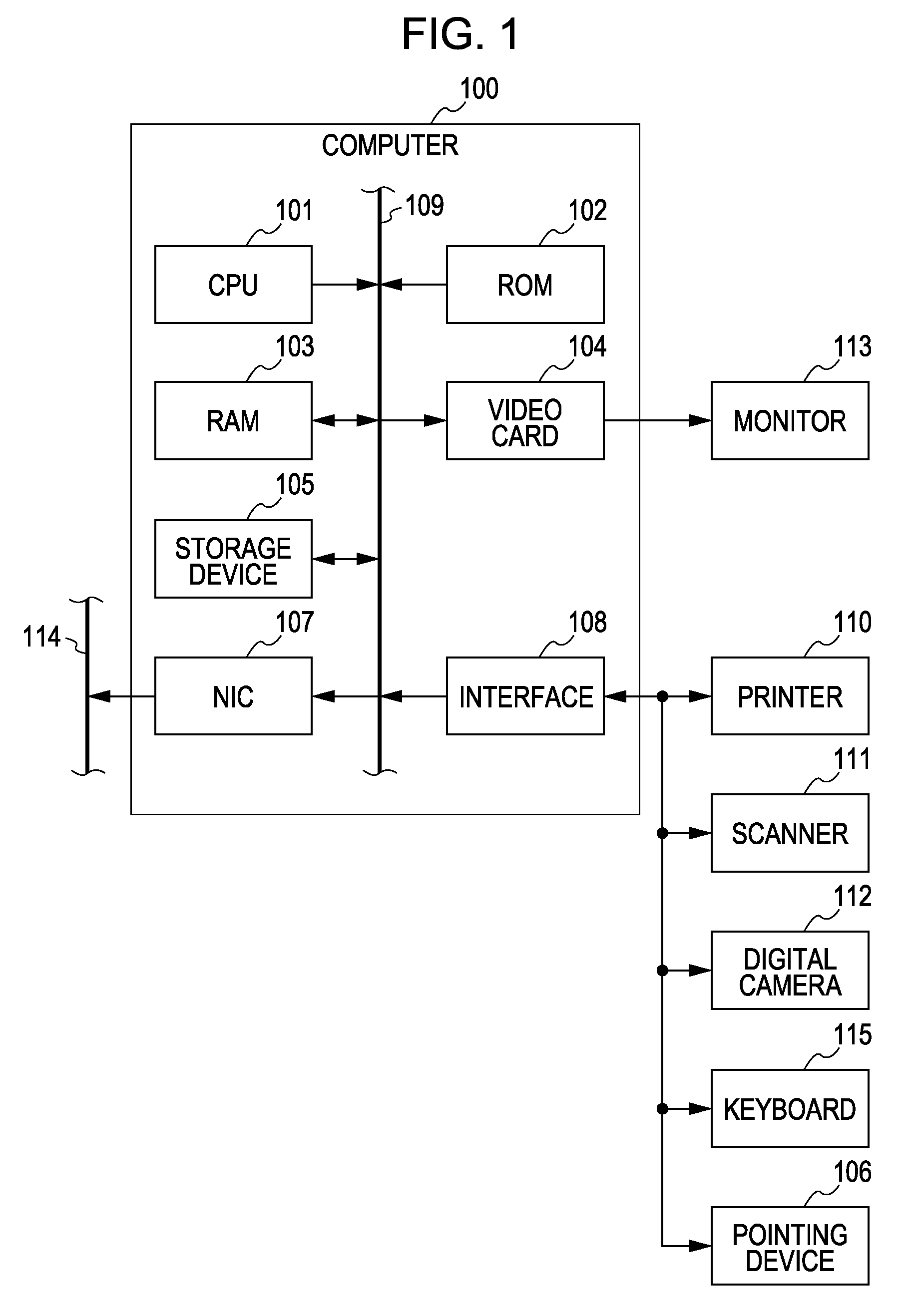Image processing apparatus, image processing method, computer program, and storage medium
a technology of image processing and image area, applied in the field of image processing apparatus and image processing method, can solve the problems of increasing the power consumption of a battery, poor color tone of an eye, damage to the facial expression of the subject, etc., and achieve the effect of accurate detection of an image area and poor color ton
- Summary
- Abstract
- Description
- Claims
- Application Information
AI Technical Summary
Benefits of technology
Problems solved by technology
Method used
Image
Examples
first embodiment
Structure
[0078]FIG. 1 is a block diagram showing an example of the structure of a computer (an image processing apparatus) performing the image processing according to a first embodiment of the present invention.
[0079] A computer 100 includes a central processing unit (CPU) 101, a read only memory (ROM) 102, a random access memory (RAM) 103, a video card 104 connected to a monitor 113 (the monitor 113 may include a touch panel), a storage device 105, such as a hard disk drive or a memory card, a serial bus interface 108 conforming to universal serial bus (USB) or IEEE 1394, and a network interface card (NIC) 107 connected to a network 114. The above components are connected to each other via a system bus 109. A pointing device 106, such as a mouse, a stylus, or a tablet, a keyboard 115, and so on are connected to the interface 108. A printer 110, a scanner 111, a digital camera 112, etc. may be connected to the interface 108.
[0080] The CPU 101 can load programs (including progra...
second embodiment
[0194] Image processing according to a second embodiment of the present invention will now be described. The same reference numerals are used in the second embodiment to identify approximately the same components as in the first embodiment. A detailed description of such components is omitted herein.
[0195] In the adaptive binarization described above in the first embodiment of the present invention, the window area 403 (refer to FIG. 4) having a predetermined size is set at the left of the target pixel (ahead of the primary scanning direction), the average Er(ave) of the evaluation amounts of the pixels in the window area 403 is calculated, and the binarization is performed by using the average Er(ave) as the threshold value depending on whether target pixel is in the red area. The number of pixels that are referred to to calculate the threshold value is small in such a method, thus increasing the speed of the processing. However, since the window area 403 is set only at the left o...
third embodiment
[0205] Image processing according to a third embodiment of the present invention will now be described. The same reference numerals are used in the third embodiment to identify approximately the same components as in the first and second embodiments. A detailed description of such components is omitted herein.
[0206] Methods of extracting a pixel in the red area by the adaptive binarization on the basis of the red evaluation amount Er defined in Equation (3) are described in the first and second embodiments of the present invention. With such methods, pixels corresponding to the outer or inner corner 2302 of the eye are possibly detected as the pixels in the red area, in addition to the pupil 2301 of the red eye shown in FIG. 23. Enlargement of the outer or inner corner 2302 of the eye shows that many “dark red” pixels having, for example, a pixel value (R,G,B)=(81,41,31) exist. The red evaluation amount Er of these pixels is equal to 49%, which is a relatively large value. Accordin...
PUM
 Login to View More
Login to View More Abstract
Description
Claims
Application Information
 Login to View More
Login to View More - R&D
- Intellectual Property
- Life Sciences
- Materials
- Tech Scout
- Unparalleled Data Quality
- Higher Quality Content
- 60% Fewer Hallucinations
Browse by: Latest US Patents, China's latest patents, Technical Efficacy Thesaurus, Application Domain, Technology Topic, Popular Technical Reports.
© 2025 PatSnap. All rights reserved.Legal|Privacy policy|Modern Slavery Act Transparency Statement|Sitemap|About US| Contact US: help@patsnap.com



